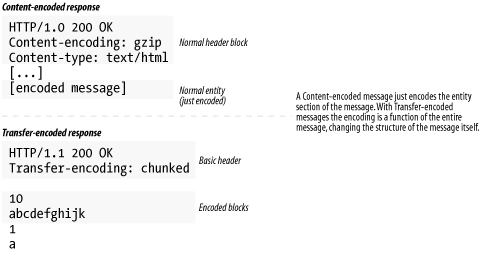Transfer Encoding and Chunked Encoding
The previous section discussed content encodings—reversible transformations applied to the body of the message. Content encodings are tightly associated with the details of the particular content format. For example, you might compress a text file with gzip, but not a JPEG file, because JPEGs don’t compress well with gzip.
This section discusses transfer encodings. Transfer encodings also are reversible transformations performed on the entity body, but they are applied for architectural reasons and are independent of the format of the content. You apply a transfer encoding to a message to change the way message data is transferred across the network (Figure 15-5).

Figure 15-5. Content encodings versus transfer encodings
Safe Transport
Historically, transfer encodings exist in other protocols to provide “safe transport” of messages across a network. The concept of safe transport has a different focus for HTTP, where the transport infrastructure is standardized and more forgiving. In HTTP, there are only a few reasons why transporting message bodies can cause trouble. Two of these are:
- Unknown size
Some gateway applications and content encoders are unable to determine the final size of a message body without generating the content first. Often, these servers would like to start sending the data before the size is known. Because HTTP requires the Content-Length ...
Get HTTP: The Definitive Guide now with the O’Reilly learning platform.
O’Reilly members experience books, live events, courses curated by job role, and more from O’Reilly and nearly 200 top publishers.

